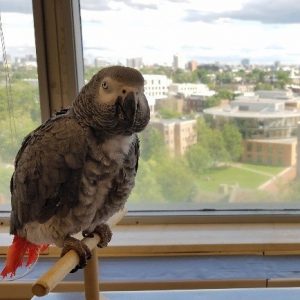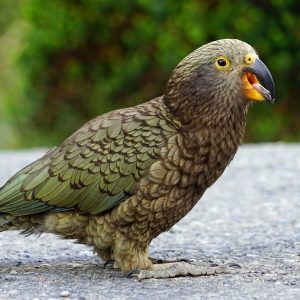
An ongoing topic of study in our lab has been contrafreeloading—working for food (or, in the case of humans, some other reward) that could simultaneously be obtained for free. Contrafreeloading is pretty much unexpected and any evidence of it is remarkable (Menzel, 1991): Why would anyone work for something if they didn’t need to do so? As it turns out, almost every species tested—except domestic cats!—contrafreeloads to some extent, depending on the task and the individual.
A few years ago, I wrote about our study comparing contrafreeloading in African greys and kea parrots. For those of who have not read that blog, I’ll summarize briefly. The main point is that the task is quite “conditional”: A particular individual may contrafreeload on one task but not another, and (as we’ll see shortly) the type of task may be species-related.
One of my students, Gabriella Smith, proposed that contrafreeloading in nonhumans would be more likely to occur if the task is fun so that the subjects get the double reward of doing something they enjoy and getting some food they would also like (Smith et al., 2021). We tested her theory with several African Grey parrots and found that, as hypothesized, considerable individual variation existed both among birds and tasks—what some birds thought was fun, others viewed as work and avoided the effort.
Kea Parrots Added to the Mix

She then had the idea and the opportunity to work with colleagues from New Zealand to test whether an ostensibly more playful species, the kea parrot, would be more likely to contrafreeload. Again, our hypothesis was somewhat supported—the kea had considerable individual variation and contrafreeloaded a bit more than the African greys on one task (involving popping lids from small cups), but pretty much completely refused to contrafreeload on a task involving de-shelling a nut (Smith et al., 2022).
In the wild, kea parrots do not de-shell nuts, but we chose the task so that we would have a direct comparison with the African greys and because we thought that, as a novel task, kea might find it interesting and fun. Unfortunately, such was not the case.
In Come the Cockatoos

But what if we could work with a playful species for whom nut-shelling was a common behavior? And where would we find enough subjects to do a meaningful study? Well, as it turned out, during COVID one of my other students, Alana Carroll, had taken a year’s leave of absence from Harvard and worked part-time at a parrot rescue—where they had four umbrella cockatoos!
No scientific studies had evaluated their playfulness, but she had worked with them for a year, reviewed lots of online videos that showed extensive playful behavior, and we found that they are closely related to other cockatoos who had been studied and whose playfulness was documented (Auersberg et al., 2014, 2015). Upon her return to school, we contacted the facility, and they agreed to let her test these birds during holiday and intersession breaks. How would these birds behave?
The data she collected only partially supported our hypothesis (Caroll & Pepperberg, 2024). We did see, as expected, great individual variation—one cockatoo, Poly, contrafreeloaded almost 71% of the time, whereas another, JJ, barely did so at all, at 4% of trials. Teddy Bear was at 25%, and Dudley was close to 58%. However, in terms of the overall relative amounts of contrafreeloading, no significant difference existed between the African greys and the cockatoos; nevertheless, more of the cockatoos contrafreeloaded at over 50% than occurred for the African greys.
Interestingly, some issues may have affected the cockatoos’ responses that were not present for the greys. The first involved housing conditions; the second involved possible boredom.
Unlike the African greys, who were all individually housed—though all could interact with other parrots—Dudley and JJ had arrived at the rescue co-housed and were kept in that situation. Dudley was clearly the dominant bird, and on occasion had stolen JJ’s reward (which was replaced). We surmise that JJ’s low level of contrfreeloading therefore might have been a consequence of his being the subordinate bird: Choosing the already de-shelled nut and eating it quickly made the most sense; if he took the nut with the shell and had to spend time de-shelling it, Dudley would have a chance to steal it! And even though Dudley was dominant, maybe he thought JJ might try to steal his nut, which could be a reason for his not contrafreeloading extensively. Of course, Teddy Bear, who was not co-housed, didn’t contrafreeload all that much…maybe, unlike Poly, he and Dudley just weren’t all that interested in the task.
As for boredom: Well, Poly, the one bird that did contrafreeload extensively, decreased her behavior at a statistically significant rate after about two-thirds of the sessions had been completed. Maybe she became tired of the task? Moreover, at the same time, she started to want to interact with Alana a lot more, apparently losing interest in the food overall in favor of social interaction.
Nevertheless, given that contrafreeloading is a behavior that is not expected to exist at all, our findings are of considerable interest. We wonder if we could find a task that the cockatoos—or other birds—might enjoy more, and if that might affect the results?
As for the take-home message for our companion animals—given that contrafreeloading and foraging behavior in captivity are related—don’t give up if your parrot doesn’t like the first foraging toy you provide…keep trying! You might simply have not found the one your bird finds enjoyable.
References
Auersperg, A. M. I., Oswald, N., Domanegg, M., Gajdon, G. K., & Bugnyar, T. (2014).Unrewarded object combinations in captive parrots. Animal Behavior and Cognition, 1(4), 470–488. https://doi.org/10.12966/abc.11.05.2014
Auersperg, A. M. I., van Horik, J. O., Bugnyar, T., Kacelnik, A., Emery, N. J., & von Bayern, A. M. P. (2015). Combinatory actions during object play in psittaciformes (Diopsittaca nobilis, Pionites melanocephala, Cacatua goffini) and corvids (Corvus corax, C monedula, C moneduloides). Journal of Comparative Psychology, 129(1), 62–71. https://doi.org/10.1037/a0038314
Carroll, A., & Pepperberg, I.M. (2024). Contrafreeloading in umbrella cockatoos (Cacatua alba): Further evaluation of the play hypothesis. Advance online publication. https://dx.doi.org/10.1037/com0000395
Menzel, E.W. (1991). Chimpanzees (Pan troglodytes): Problem seeking versus the bird-in-hand, least-effort strategy. Primates, 32, 497–508. https://doi.org/10.1007/BF02381940
Smith, G. E., Bastos, A. P. M., Chodorow, M., Taylor, A. H., & Pepperberg, I. M. (2022). Contrafreeloading in kea (Nestor notabilis) in comparison to Grey parrots (Psittacus erithacus). Scientific Reports, 12(1), Article 17415. https://doi.org/10.1038/s41598-022-21370-6
Smith, G. E., Greene, D., Hartsfield, L. A., & Pepperberg, I. M. (2021). Initial evidence for eliciting contrafreeloading in Grey parrots (Psittacus erithacus) via the opportunity for playful foraging. Journal of Comparative Psychology, 135(4), 516–533. https://doi.org/10.1037/com0000295
